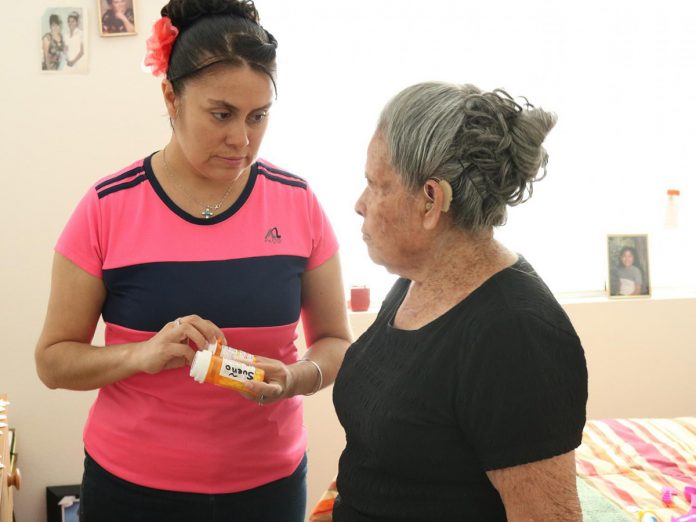Dr Lynn Woods, Professor in the Department of Doctoral Programs, School of Nursing, Azusa Pacific University, explores behavioural symptoms of dementia in the Latinx population
The world population is ageing. By 2050, those over 65 will comprise 17% of the world population. Those over 85 are the fastest-growing group, increasing fivefold by 2050, a historical first. The ageing population is also increasing in diversity. In the United States, Latinx account for more population growth than any other ethnic group and by 2030, will increase by 202%. With an increasing lifespan comes the increased risk of dementia. Moreover, dementia among older Latinx is 1.5 times higher than non-Latinx, differences that remain in those > 85 years. Additionally, differences are seen in Latino subgroups. For example, Caribbean Latinx have a higher risk than Mexican Americans. Since age is a major risk factor for Alzheimer’s disease and related dementias, it is anticipated that the number of Latinx with dementia will increase significantly, bringing further increases in those with dementia and behavioural symptoms.
Dementia also has a substantial economic impact. The cost to the U.S. economy was around $236 billion in 2019. Direct costs for Latinx with dementia are anticipated to more than double by 2030 to 19.6 billion, and 65.7 billion by 2060, while indirect costs, such as informal care and wage losses are expected to increase to 39.8 billion by 2060.
The impact of dementia
Dementia is a syndrome characterised by a deterioration in cognitive ability, thought processes and behaviour. As dementia progresses, most persons with dementia exhibit some form of behavioural symptoms of dementia (BSD), sometimes referred to as non-cognitive symptoms of dementia and neuropsychiatric symptoms of dementia (NPSD). Behavioural symptoms of dementia (BSD) include sleep disturbances, agitation, hallucinations, extreme emotions, wandering, and resistance to care. Dementia is one of the major causes of disability and dependency amongst older adults and can have a substantial physical, psychological, and social impact on individuals living with the condition and those around them. However, in Latino families, the impact is even more pronounced than in other ethnic groups. Familismo (Family) to Latinx means that family always comes first. For Latinx, dementia is a family affair. Rather than being viewed as self-sacrifice, it is viewed more as an honour to support the family.
Since ethnic minorities are often underrepresented in dementia research, our understanding of BSD, the complexity of caregiving and the part that Familismo plays is limited. Thus, while there have been few studies focused on BSD in Latinx, the few that exist found that Latinx with dementia exhibited more behaviours such as agitation than non-Latinx with dementia, 57% compared to 46%. This may be due to Latinx receiving a dementia diagnosis at a much later stage than their White counterparts, thus increasing the risk of BSD which are typically seen in the middle stages of dementia.
Latinx culture and dementia
Latinx culture is heterogeneous with differences in Mexico, Puerto Rico, Cuba, and Central and South America. A later diagnosis of dementia is influenced by cultural factors which colour the interpretation and recognition of changing behaviour, indicative of increasing dementia. For example, in the Latinx culture, there is a high level of respect for elders, leading to a reluctance to acknowledge changes in cognition and/or behaviour. Indeed, previous research shows that 65% of Latinx caregivers dismissed symptoms of dementia due to the belief that it is a normal part of ageing.
Moreover, on relocating to the United States, ethnic minority elders choose to retain their traditional healing practices that incorporate spiritual beliefs. Caregivers in Latinx families often seek help from traditional healers and may be reluctant to use more formal services, relying on extended family to help. Understanding the complexity of how a particular caregiver is experiencing Familismo and how it relates to their experience of caregiving is critical. One size does not fit all. Indeed, positive outcomes are evident when providers use an inclusive approach with language such as “we” instead of “I” when providing care and/or consultation.
While fully aware of the rich diversity among Latinx communities, there are several cultural concepts in addition to Familismo that should be considered. These include respect/respeto, personal relationship/personalismo, trust/confianza, spirit/espiritu and presence/presentismo. Culturally congruent care is important to engender trust. For example, if a family hires someone from outside, the family, the trust and comfort level is increased if they receive help from a caregiver who speaks the language and is from the same culture.
As one daughter stated: “As a Latina daughter and granddaughter with Mexican heritage, watching my mother being a caregiver for her father, my grandfather, was very difficult for me. I did not know how to help. When my grandfather got sick, the doctors wanted my Mom to place him in a nursing home because he was completely paralysed, unable to communicate, and wholly dependent. The only advice given was to put him into care. Not something that was done in our family. However, my mother rejected that advice as personally and culturally incompatible and moved him into her home. She had to make many modifications to her house, switched to working the night shift and also hired an additional Spanish speaking caregiver, whose heritage was Mexican, to watch my grandfather.”
Pharmacological & non-pharmacological interventions
Pharmacological and non-pharmacological interventions are available for treating BSD. However, behaviours and behavioural changes must be thoroughly assessed before any treatment is initiated.
Pharmacological interventions, mainly psychotropic medications, including antipsychotics, antidepressants and sedative-hypnotics are frequently used to treat BSD, although they are not recommended as the first line of treatment. They may be used, but sparingly, if at all. The outcomes of psychotropic medications are frequently less than hoped for. Frequent side effects of these medications are increased agitation, akathisia, often mistaken for an increase in BSD, an indication that the medication should be reduced. Recent research indicates that 30% of those taking psychotropic medications have a high risk of mortality. Additionally, genetic factors in different ethnic groups influence the effectiveness of these medications, an area that warrants further investigation.
Non-pharmacological interventions are recommended as the first line of treatment for behavioural symptoms of dementia. Culturally congruent activities that engage and connect are especially important for Latinx with dementia, such as familiar music and dancing. While not specific to Latinx with dementia, some examples of other non-pharmacological treatments are cognitive/emotion-focused therapy (reminiscence therapy), sensory stimulation (e.g., aromatherapy; massage/ touch therapy), and other psychosocial interventions (e.g., animal-assisted therapy). Those with a sensory focus show more promise than others and for Latinx, may very well be more culturally congruent. By applying Latinx cultural strengths, Latinx persons with dementia can benefit from individually and culturally tailored treatments. The lack of research and information about specific interventions that might be helpful in this community, emphasises the need for further research.
Dementia (BSD) research priorities
There is a need for interdisciplinary research into BSD, specifically within the Latinx population to further elucidate specifically adapted interventions for BSD. The importance of healthcare providers acquiring knowledge about traditional healing practices that many Hispanic/Latinos use cannot be underestimated. Collaboration with healers can achieve positive treatment outcomes. Psychotropic medications should be used with extreme caution due to the many negative side effects. As for non-pharmacological interventions, further research is needed so that current recommendations can be implemented.
Given the underrepresentation of older Latinx in dementia research, our understanding of differences in BSD and treatment remains limited. With the projected increase of older Latinx and the increased risk for dementia and BSD, future dementia research must include this population to help us understand the similarities and differences in BSD across Latinx subgroups.
I want to acknowledge the contribution of Olga I. Covarrubias, Walden University, MSW Candidate.
References
Rodrguez, J. and Padilla-Martinez, V (2020) Latino families living with dementia: Behavioral issues and placement considerations. In H. Y. Adames, Y. N. Tazeau (eds.), Caring for Latinxs with Dementia.in a Globalized World (pp. 133-153).
Woods, D.L. (2020). Behavioral symptoms of dementia in Latinos: Pharmacological, non-pharmacological, and ethnocultural healthcare interventions. In H. Y. Adames, Y. N. Tazeau (eds.) Caring for Latinxs with Dementia in a Globalized World (pp. 187-203).
Galik, E. (2016). Treatment of dementia: Non- pharmacological approaches. In M. Boltz and J.E. Galvin (Eds.) Dementia care: An evidence approach (pp. 97-112). Switzerland: Springer McRae, J. (1987) Therapeutic Touch: A Practical Guide. Alfred A. Knopf Inc: New York.
Gerdner, L.A. (2015). Ethnicity is an inherent criterion for assessment of individualized music for persons with Alzheimer’s disease. Clinical Gerontologist, 38(2), 179–186.
Please note: This is a commercial profile
© 2019. This work is licensed under CC-BY-NC-ND.








